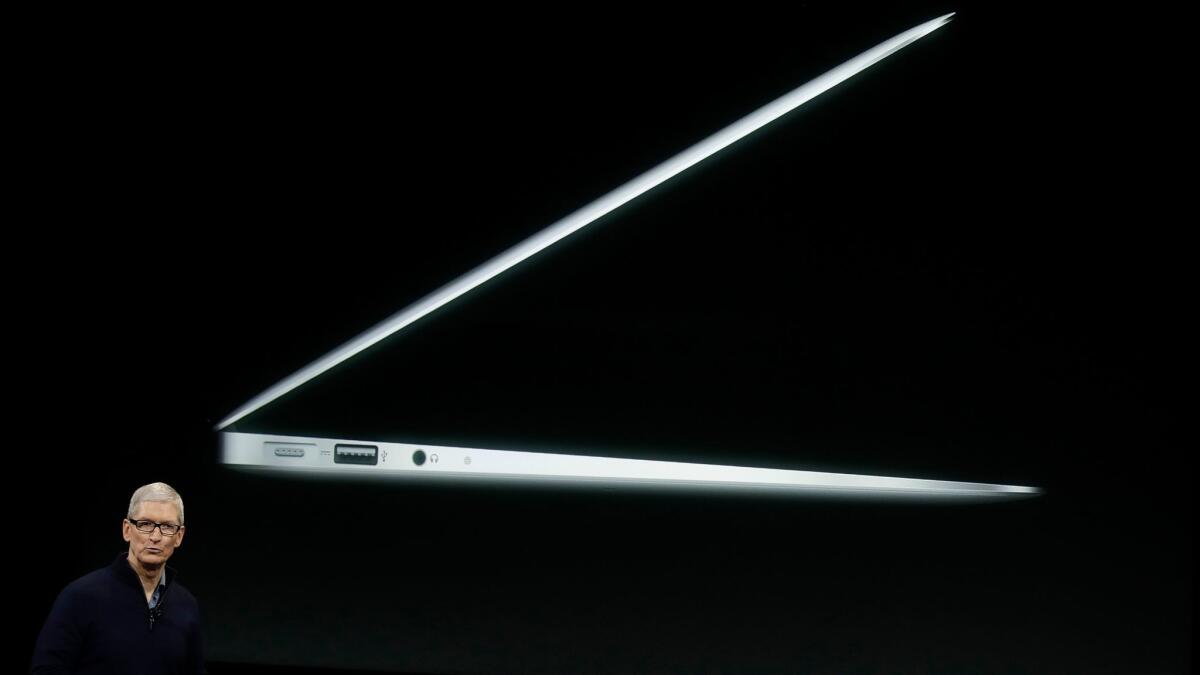Once again, Apple’s new design won’t accommodate your old cords

Apple Inc. Chief Executive Tim Cook speaks about MacBook computers during an announcement of new products on Thursday.
Not everyone was happy when Apple removed the headphone jack from its new line of iPhones, forcing customers to go wireless or use an adapter.
And, unsurprisingly, not everyone was happy Thursday when owners of Apple’s new iPhones realized they won’t be able to charge them using the latest MacBook Pro models without using a different adapter.
The revelation came as the tech giant unveiled new MacBook Pro laptops featuring a touch-sensitive bar atop the keyboard. But it was the USB ports — or lack thereof — that were the center of attention for some users.
The iPhone 7 will no longer plug directly into Apple’s premier laptops because the smartphone comes with a Lightning cable that fits into a standard USB port. The new laptops use different USB-C ports — and they don’t ship with cords that match an iPhone.
To make them compatible, Apple customers will have to buy a $19 adapter, more commonly known in the tech world as a “dongle.” Or they could buy a $25 charger cable that directly connects the USB-C port to their phone.
The future’s tangle of cords and dongles elicited some heated tweets from users.
Apple is known for its proprietary cords and it’s willingness to frequently change them.
This latest shift is part of Apple’s move toward a wireless future — meaning the company may be hoping that customers don’t wind up using dongles.
“Going forward, wireless will be the more convenient thing,” said Werner Goertz, research director of personal technologies at research firm Gartner. “It offers all the bandwidth things need to communicate with each other.”
Apple wants iPhone users to rely on iCloud, its data storage service, to transfer files between devices, leaving the cord only for charging.
On its laptops, the smaller size of the USB-C port — which is becoming more common in personal devices — helps keeps the device slim.
“I would say that’s very much a part of Apple’s DNA — ‘ever thinner,’ and sometimes that means making sacrifices,” said Tom Mainelli, vice president for devices at market research firm IDC.
But, if you’re someone who likes to plug in your devices to your laptop, “you’re going to use a lot of dongles to get your stuff plugged in,” he said.
And if you want those dongles, you’re going to have to pay for them.
While the cords are much less expensive than the company’s laptops, forcing customers to buy them could provide a bit of extra revenue as its computer line faces increased competition.
In its fourth quarter report released this month, Apple said many of its rivals have broader product lines and cheaper prices, meaning the Mac has to “maintain its functional and design advantages.”
Apple sold about 18.4 million Mac computers in 2016, compared to about 20.5 million in 2015.
Twitter: @smasunaga
ALSO:
AT&T and Time Warner hope to break the cycle of failed mergers
What your boss can and can’t do when it comes to politics at work
Column: Who oversees data brokers selling your personal info? No one







